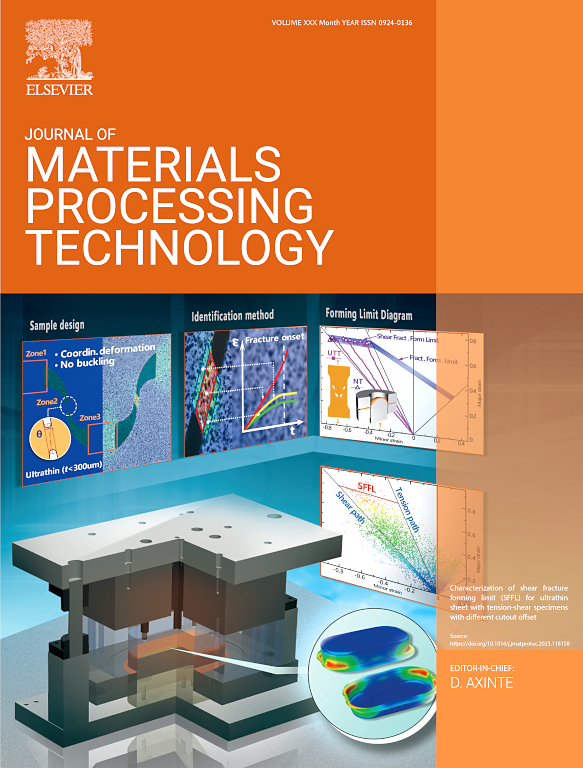Eliminating bottom defects in medium-thickness titanium alloy joints by improving material flow via a new dynamic rotation supporting friction stir welding method
IF 6.7
2区 材料科学
Q1 ENGINEERING, INDUSTRIAL
Journal of Materials Processing Technology
Pub Date : 2025-05-14
DOI:10.1016/j.jmatprotec.2025.118900
引用次数: 0
Abstract
It is generally difficult to eliminate bottom defects during friction stir welding (FSW) of medium-thick/thick Ti alloy plates, since there still lacks of deep understanding of the material flow mechanism influencing the formation of bottom defects. In this study, different variant FSW methods were conducted to 7 mm Ti-6Al-4V alloy plates, and the oxide tracking method was utilized to study the material flow mechanism. During conventional dynamic supporting FSW, the main reason for bottom defects was related to cavities formed in the bottom at the initial stage and not filling in time during welding. A new dynamic rotation supporting FSW (DRSFSW) method with a movable bottom rotating shoulder instead of the traditional backing plate was first time proposed to eliminate bottom defects in Ti alloy joints. The essential cause of eliminating bottom defects was associated with the fact that the bottom rotating shoulder added an extra reverse material flow pattern to avoid initial defects, following by fuller material flow and faster material filling rates during the welding. The high-temperature phase reconstruction method showed that colonies with high orientation consistency was largely promoted to form by more sufficient deformation, fully dynamic recrystallisation and fewer nucleation sites after adding the extra reverse material flow pattern during DRSFSW. The joint strength reached 971 MPa, with a joint strength coefficient of 96.8 %. This study uncovers the material flow pattern for FSW with different bottom states and provides a new method to enlarge the welding window and improve the quality of FSW Ti alloy joints.
采用一种新的动态旋转支撑搅拌摩擦焊接方法,改善材料流动,消除中厚钛合金接头底部缺陷
中厚/厚钛合金板搅拌摩擦焊过程中,由于对影响底部缺陷形成的物质流动机制缺乏深入的认识,一般难以消除底部缺陷。在本研究中,对7 mm Ti-6Al-4V合金板进行了不同的FSW方法,并利用氧化物跟踪法研究了材料的流动机理。在传统的动态支撑型FSW中,产生底部缺陷的主要原因是初期在底部形成空腔,而在焊接过程中没有及时填充。首次提出了一种新的动态旋转支承FSW (DRSFSW)方法,该方法采用可移动的底部旋转肩代替传统的支承板,以消除钛合金接头底部缺陷。消除底部缺陷的根本原因与底部旋转肩增加了额外的反向材料流模式有关,以避免初始缺陷,随后在焊接过程中产生更充分的材料流和更快的材料填充率。高温相重建方法表明,在DRSFSW过程中加入额外的反向流型后,更充分的变形、充分的动态再结晶和更少的成核位点,在很大程度上促进了取向一致性高的菌落的形成。节理强度达到971 MPa,节理强度系数为96.8% %。本研究揭示了不同底态摩擦焊材料的流动规律,为扩大焊接窗口、提高摩擦焊钛合金接头质量提供了一种新的方法。
本文章由计算机程序翻译,如有差异,请以英文原文为准。
求助全文
约1分钟内获得全文
求助全文
来源期刊

Journal of Materials Processing Technology
工程技术-材料科学:综合
CiteScore
12.60
自引率
4.80%
发文量
403
审稿时长
29 days
期刊介绍:
The Journal of Materials Processing Technology covers the processing techniques used in manufacturing components from metals and other materials. The journal aims to publish full research papers of original, significant and rigorous work and so to contribute to increased production efficiency and improved component performance.
Areas of interest to the journal include:
• Casting, forming and machining
• Additive processing and joining technologies
• The evolution of material properties under the specific conditions met in manufacturing processes
• Surface engineering when it relates specifically to a manufacturing process
• Design and behavior of equipment and tools.
 求助内容:
求助内容: 应助结果提醒方式:
应助结果提醒方式:


